Reference Studio AudioWeave 4K In-Ceiling Motorized Tab Tension Screen
No Compromise

In-ceiling Installation for Ultimate Invisible Integration
Integrating your motorized screen into any room has never been so easy. Our all-aluminum casing and unique mounting solution allows you to place your screen flush inside the ceiling without hassle, and with no drywall patching required. The screen can be mounted using a variety of methods, including steel rods, aircraft cables, or by direct bolt-on method.
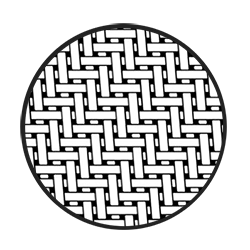
Mind-Blowing Audio Performance with Exceptional Image Clarity
Our specially engineered woven screen material allows content to be projected with near perfect pixel accuracy. This means you’ll enjoy bright and clear images, with better contrasts and more vivid colors, without losing out on sound quality.
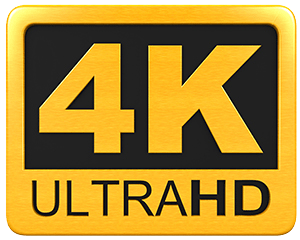
No Compromise: Full 1080p and 4K
The finest, tightest-woven and smooth weave pattern means that finally, an acoustic weave screen with reference level audio and video performance has arrived.

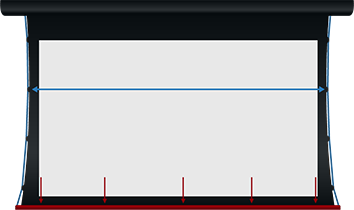
Smooth Projection Surface with Pure-Flat Technology
The purposefully designed Pure-Flat tensioning system provides a perfectly flat picture to eliminate projected image distortion, ensuring a perfect canvas for any type of projected media.
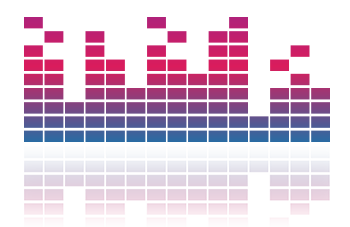
Unmatched Acoustic Transparency
Audio Transparency is the most important aspect of any Acoustic Weave screen. The ideal scenario is to have the screen material let all of the audio frequencies pass through it with zero attenuation.

See your movies as they are meant to be seen
Experience the most vivid colors and crystal clear audio, on a projector screen that has been designed to transport you to another world. Hear every whisper, see every detail, and be swept away to another time and place, living a different life, even if it’s only for the evening.
See your movies as they were meant to be seen
Experience the most vivid colors and crystal clear audio, on a projector screen that has been designed to transport you to another world. Hear every whisper, see every detail, and be swept away to another time and place, living a different life, even if it’s only for the evening.
Reference Studio AudioWeave 4K In-Ceiling Motorized Tab Tension Features
The screen is designed for ease of installation in mind. In most cases, the Reference Studio 4K In-Ceiling Tab-Tensioned screen can be installed long after drywalling, as well as before drywalling a new room. This makes the screen perfect for retrofit installations, as no additional hole is required to attach the screen to the ceiling due to our unique mounting solution.
The unique sliding mounts mean that the screen can be bolted to the ceiling along any point, and can be installed very easily before drywalling. The removable plastic caps on the sides, in addition to mounts that can slide right above the plastic caps, means that only one cutout is needed to fit the screen inside the ceiling.
General Screen Installation Steps:
-
Cut a hole in the ceiling to fit screen housing size, as indicated by dimensions and manual.
-
Reinforce the ceiling if necessary, bolt mounts into wood, concrete etc.
-
Close plastic covers to finish the installation.
Please note that these are general steps which are valid for a large percentage of homes. You and your contractor would be responsible to make sure the screen can be installed in the desired location prior to cutting into the ceiling, and that you can get a power source in the installation location to plug the screen into.
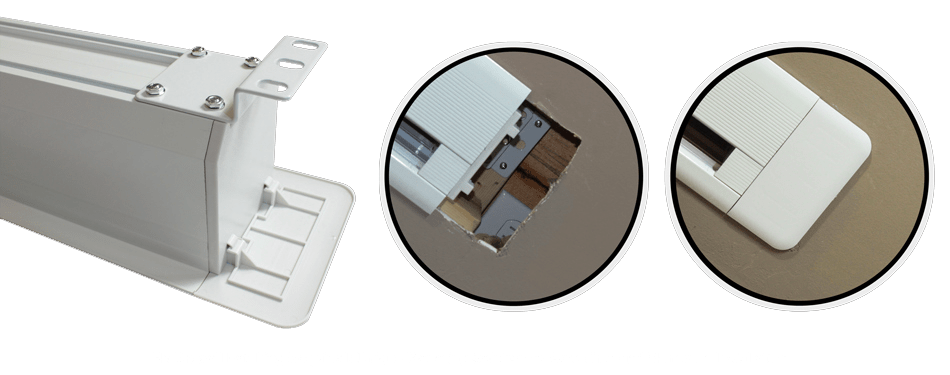
Reference Audio Performance
During the Research and Development phase of the screen, the key factors that make a good acoustically transparent screen were determined:
- Sound Transparency: the ideal screen should not alter the sound signal from the speakers in any way.
- Video Transparency: the ideal screen should match the performance of our Reference Studio 4K 100 material, which does not degrade the video source in any way.
- Produce the highest density of sound perforations to ensure lowest acoustical attenuation in the industry.
- Minimize the perforation size and total perforation surface area to reduce light leakage and increase image sharpness.
- Produce a fine weave pattern that is as smooth as possible.
- Introduce an angular shift to the weave pattern, so that the pixels of the projector do not align with the pattern, thus eliminating moiré.
- Minimize the thickness of the material without compromising material integrity or video integrity, thus giving maximum audio transparency.
- Absorb the minimal amount of light that does leak from the tiny perforations on screen with a sound transparent black backing
Unmatched Acoustic Transparency
Audio Transparency is the most important aspect of any Acoustic Weave screen. The ideal scenario is to have the screen material let all of the audio frequencies pass through it with zero attenuation. Of course, this is the engineering ideal, and cannot be achieved in actual practice. However, with careful design, a very small and inaudible linear attenuation with no comb filtering is possible. This is what the Reference Studio AudioWeave 4K material achieves.
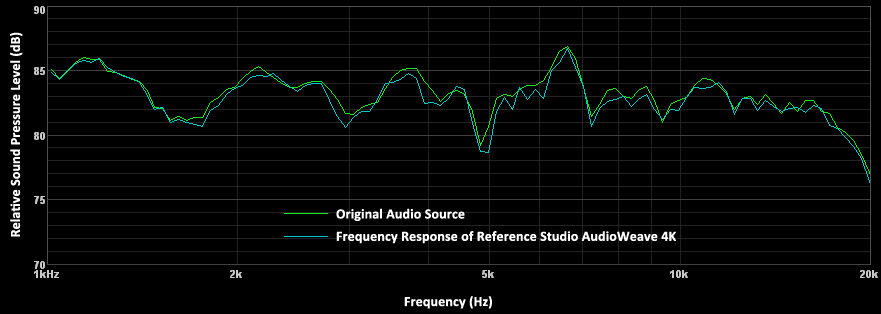
The graph above shows that the AudioWeave 4K follows the original speaker frequency response very closely, with less than 0.35dB attenuation on average, an industry-best.
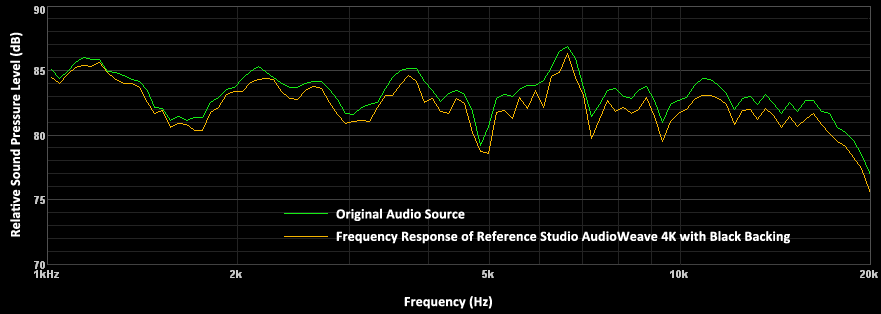
These results show that AudioWeave 4K material in combination with the specially designed black backing shows an average of less than 0.75dB overall attenuation. The attenuation is very linear, as the curves closely match each other. This performance, again, is an unmatched performance on a weave screen with a black backing.
To illustrate further, let’s see how the Reference Studio AudioWeave 4K’s performance compares to what is currently understood as the weave material performance leader (which can be purchased for anywhere from 2.5x to 3.5x the cost of our AudioWeave screen in the same size) as well as a typical “bargain” weave material (which can be purchased for anywhere between 0.8x to 1.5x the cost of our AudioWeave screen in the same size):
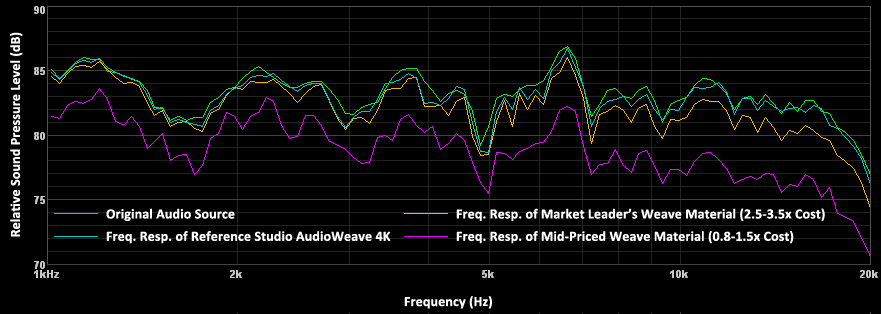
Remember, the dB Scale is not a linear scale, so a doubling in dB attenuation is a huge difference in relative % attenuation (for more information, see table below). This above results clearly shows that the AudioWeave 4K material has better performance than both the most expensive/highly rated materials available, which can cost as much as 3.5x the price as the Reference Studio AudioWeave 4K NanoEdge and still have frequency roll-off as we increase in the frequency spectrum, thus causing a great deal of harmonic distortion.
What this means is that simply increasing the dB output of the affected speaker will not get rid of the problem, because the competitors’ material is not simply attenuating the audio source, it is fundamentally changing it by attenuating different frequencies by vastly different amounts. The below table summarizes how the above dB attenuation transfers into linear attenuation. We can see below that the AudioWeave 4K material barely attenuates the whole range of audible frequencies (having a very small difference in attenuation between low frequencies and high frequencies), whereas even the most expensive alternatives do an extremely poor job of passing sound through them (having an over 30% difference in attenuation between the lower and higher frequencies).

This extreme attenuation of middle frequencies will be extremely noticeable, and loss of higher frequencies results in a loss of “airiness” and “sparkle” to the sound. The mid-frequency attenuation will affect the performance of virtually all audio coming out of your speaker, no matter the genre. The high-frequency attenuation will be very pronounced in high frequency instruments such as the violin, piccolo, clarinet, cymbals and piano. Furthermore, a variety of movie scenes (everything from a scene of a busy street in New York during rush-hour to a World War II movie action scene) will sound nothing like the makers of the movie intended. EluneVision Reference Studio AudioWeave 4K is the only material to keep its linearity all the way up to 20kHz (the highest audible frequency by humans) and have virtually no attenuation for a fraction of the price of the supposed high-performance competitors.
The fact that the performance of even the best $3000 – $5000 screens out there is not high enough and means you still have to perform expensive equalization is not acceptable to us, and it should not be acceptable to the consumer. EluneVision is thus changing what was conventionally thought of as a high-performing audio-transparent material – no longer will you have to perform expensive and time-consuming equalization on your speakers in order to get the most out of your audio setup.
The above graph shows that, in addition to having substantially better performance than its peers which cost numerous times more, our AudioWeave material is in a much higher performance class versus materials close to its price-point (0.8 to 1.5x of our screen prices). With the EluneVision Reference Studio AudioWeave 4K NanoEdge, there is no compromise.
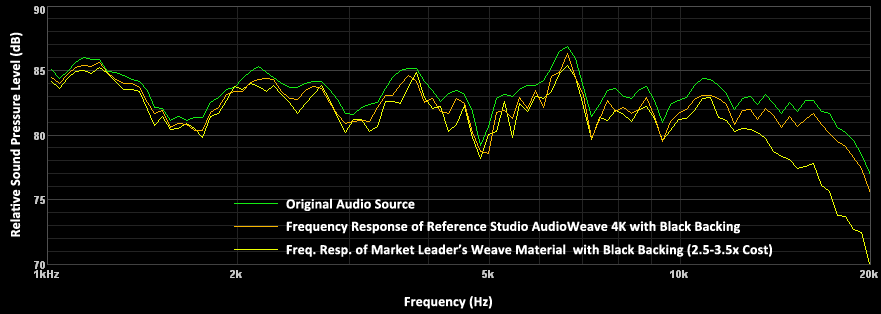
The graph above shows the performance of the AudioWeave 4K vs the current performance leader’s weave with the use of each company’s respective black backings, which are used to black out any light that goes through the holes of the weaves. From the above graph, it is clearly evident that the AudioWeave material with its black backing follows the original signal very closely and very linearly, with a slight 0.35dB attenuation – meaning that there is virtually no harmonic distortion. The current performance leader, on the other hand, suffers even more pronounced problems than it had without the black backing – overall attenuation is higher than the AudioWeave 4K material, not at all linear, and hence suffers from a great deal of harmonic distortion. Once again, the AudioWeave 4K shows that it will outperform any acoustic material, now matter the cost.
Finally, for reference, we include the audio performance comparison of the AudioWeave 4K versus a typical perforated, non-weave material.
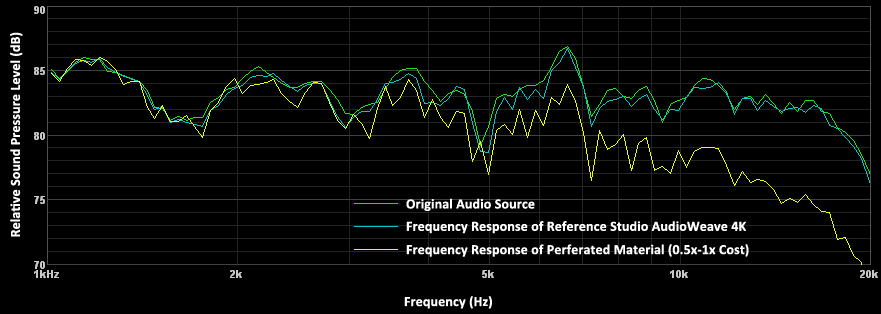
We leave it as self evident that whether a competing material is a low-end perforated, a low-cost/low-end or a high-cost/high-end weave material, the EluneVision Reference Studio AudioWeave 4K material stands alone as the best-performing acoustically transparent material. Furthermore, screens featuring the AudioWeave 4K material have a price-performance ratio never before seen.
Testing Methodology: The original frequency response is a ProAC Response 1SC monitor with Classic 16.0 Tube Amplifier, using EL34 Ultralinear mode (Frequency response 8HZ-82Khz, 10W RMS) as the amplification stage. The microphone used is the Behringer ECM8000, which was calibrated prior to testing. Testing was done with 1/24 octave resolution and 20HZ speed tradeoff. The material is 12” from the speaker and 55” from the microphone, and placed in an anechoic chamber.
Superior Audio Transparency Explained
The reasons for the inferior performance of the standard perforated material is that the perforations are too large and too few in number. With a holes size of 0.05” in diameter (1.27mm) and only 36 holes per square inch, physics simply dictates that frequencies above 1000Hz will begin to roll-off and certain frequencies will be cut off more than others, with a prevailing pattern of more attenuation as frequency increases.
As perforation size decreases and the hole density is increased, the audio transparency improves. This is where the EluneVision Reference Studio AudioWeave 4K material excels. With over 2000 holes/in2, our material has over 3x the holes per square inch than common mid-range weave materials which roughly match us in price, and over 33% more holes per square inch than our nearest performance competitor, which costs an astonishing 2.5x to 3.5x the price of our Reference Studio AudioWeave 4K NanoEdge screens. At the same time, each of our holes are about 85% smaller than common mid-range materials, and 25% smaller than the highest-end offerings, which allows our material to offer the best audio performance, while taking absolutely no performance hit in video performance.
The other reason is material thickness. The greater the mass of material in front the speaker, the greater the sound attenuation and distortion. Our material was engineered to be as thin, smooth and light as possible without compromising on video quality or material integrity.
The end result is that our material is truly audio-transparent, while other high-end offerings still require expensive and time-consuming equalization.
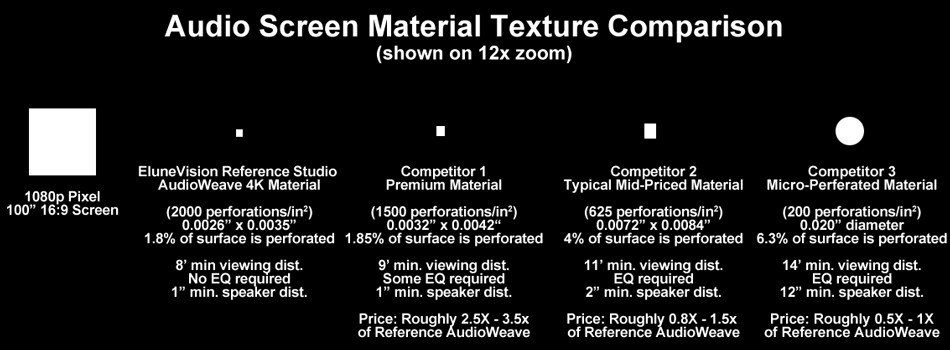
Speaker Positioning
The most important speakers in a 5.1 or 7.1 audio setup are the front 3 speakers – the left, center and right channels. The center channel is the most important channel out of the three. Most of the dialogue in movies comes through the center channel; therefore it is imperative that the sound quality of the center channel is at its best. Typically, most center channels are located above or below the screen, which compromises their sound quality by lowering horizontal dispersion. The ideal scenario is to have the center channel directly in center of the screen flanked by the left and right channels.

Whether going with a 5.1 or a 7.1 speaker setup, the center channel’s optimum position will always be in the center of the screen, at ear-level. Moreover, in a projection home theater, where the screen is typically much larger and wider than a traditional TV, the left and right speaker’s optimal position are often behind the screen as well. This makes EluneVision Reference Studio AudioWeave 4K NanoEdge screens the ideal choice for any projection home theater.
Speaker Setup
Due to the transparency of the AudioWeave 4K material to sound, the only compensation required is to increase the SPL of the front speakers by 0.35dB (or 0.75dB if black backing is used) to compensate for the slight attenuation. The fact that this is the only compensation is important, as it is extremely simple for anyone to do. There will be no equalization required as the mid-range frequencies are not filtered out by the screen, and there no loss of the sound or “sparkle” on the high-end frequencies. Equalization poses a problem, as it is often time-consuming, and requires the use of expensive, trained professionals – this makes our AudioWeave 4K material the best, as it is the first material where absolutely no equalization is required. With the Reference Studio AudioWeave 4K NanoEdge, your home theater setup can also easily be used to listen to 2.0 channel stereo music and CDs with flawless audio quality.
Maximum Resolution and Detail Reproduction with Minimum Light Leakage
The EluneVision Reference Studio AudioWeave 4K NanoEdge is engineered as very finely weaved material with holes that are only 0.0026 x 0.0035″. This means only 1.8% of the surface area of the screen is actually composed of empty space. The finer and smoother weave pattern minimizes texturing and viewing distance, resulting in the capture of every detail from 1080P to 4K. Furthermore, the reduced light leakage means that more of the projectors light is returned to the viewer and not wasted, ensuring a crisp, bright image.
Above, we have a comparison of two images, with the same frame of the same movie being shown on the Reference Studio 4K 100 material and the Reference Studio AudioWeave 4K material from 8 feet away. This particular frame was chosen for a special reason: the whole image has the whole range of brightness, from the deepest of blacks, to the brightest of whites. These photographs illustrate very clearly that a premium was placed on making the Reference Studio AudioWeave 4K material not only the best material for audio-transparency, but also one that will not make the user have to choose between the best audio experience versus the best video experience. The Reference Studio AudioWeave 4K handles this any dynamic colour range with ease, without degrading resolution or image performance. The material is definitely a no compromise material from a video performance perspective.
Moire Free With All Projection Technologies
Moiré is typically an issue with all acoustic weave screens. The Reference Studio AudioWeave 4K material completely eliminates this issue. Moiré appears when the pattern of the weave matches the grid pattern of the projector. To resolve this issue, the material pattern is 15 degrees off the vertical so to completely remove moiré. Furthermore, the pattern of the AudioWeave 4K is so fine that it is often smaller than the projector pixel pattern, meaning yet another layer of protection against moiré.
The Reference Studio AudioWeave 4K material has been tested with LCD, DLP, D-ILA and SXRD projectors to ensure a moiré-free picture at various throw distances and viewing angles.
To the left is an example of how moiré can impact picture quality. When you zoom in, you see that the competitor’s screen creates moiré on the woman’s dress, causing artifacting patterns that are not supposed to be on the image. This is due to the fact that their weave material is not rotated by 15 degrees, so the pixel structure is too closely aligned with the material’s weave. Furthermore, the moiré pattern also causes discoloration, as green hues are introduced on what is supposed to be a completely blue dress in the competitor’s image.
Reference-Class 2D and 3D Performance
The Reference Studio AudioWeave 4K material is designed to maximize detail, resolution and uniformity for both 2D and 3D projection. To get the best 3D immersive experience, the screen must be free from artifacts, hot spots and as texture-less as possible. Any flaw in the material and in the reproduction will contribute to a loss of immersion and viewer fatigue due to increased cross talk.
Seamless Video Reproduction with Contrast Enhancing Sound Transparent Black Backing
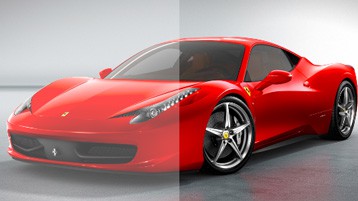
The black backing is one of the most important aspects of an acoustic weave fixed frame screen. All acoustic weave screens will leak a bit of light due to the perforations in the screen. This light can then hit the surfaces behind the screen and bounce back into the material and thus lowering black levels.
To combat this problem, a specially designed, highly porous and low-density black backing is used to absorb the light leakage and provide better black levels. Not only does this enhance video performance, but as demonstrated above in the audio section, it will not negatively impact the audio performance of your home theater setup.
Engineered for Active 3D and 2D with 1.15 Gain
With a gain of 1.15, one of the highest gains for acoustic weave materials; the Reference Studio AudioWeave 4K NanoEdge delivers high contrast images without any of the drawbacks of high gain screens such as hot spotting, texturing and graininess. The higher gain helps with brightness of the projected image and counters the loss of brightness due to active 3D shutter glasses.
Near-Perfect Lambertian Diffuser Viewing Surface
The thread used to weave the Reference Studio AudioWeave 4K material is chosen for its Near-Perfect Lambertian Diffusing properties. The end result is that you get a screen that is has a full 180 degree viewing angle and does not suffer from the effects of hot spotting, graininess, or texturing. The screen under proper usage conditions (viewing distance greater than 8 feet) will remain a near perfect canvas for the projector.
The surface of a material exhibits lambertian reflectance if the viewer sees the same image or brightness regardless of the viewer’s angle. From a more technical perspective, this means the incident light is scattered in all directions equally. A good example of this is an unfinished block of wood, where no matter what angle you view it, the luminance is roughly equal. In contrast, finished wood with a glossy coat of polyurethane exhibits specular highlights, which are areas of brighter luminance when viewing at different angles. While this glossy finish may be beneficial on furniture, it is the cause of numerous problems in projection screens.
Extremely Fine and Smooth Weave to Maximize Detail Clarity
At EluneVision, much effort was spent designing a projection material that is as smooth as possible. The Reference AudioWeave 4K NanoEdge screen uses a specially designed ultra smooth and fine weave that maximizes the picture sharpness while minimizing light leakage. This fine weave preserves the pixel structure, thereby giving the highest detail clarity, sharpness and definition of any projection screen released to date. This means, simply, that the geometry of each projected pixel remains as the projector manufacturer intended.
To illustrate this point, see the screen material texture comparison below, showing our Reference Studio AudioWeave 4K material beside the industry’s best materials.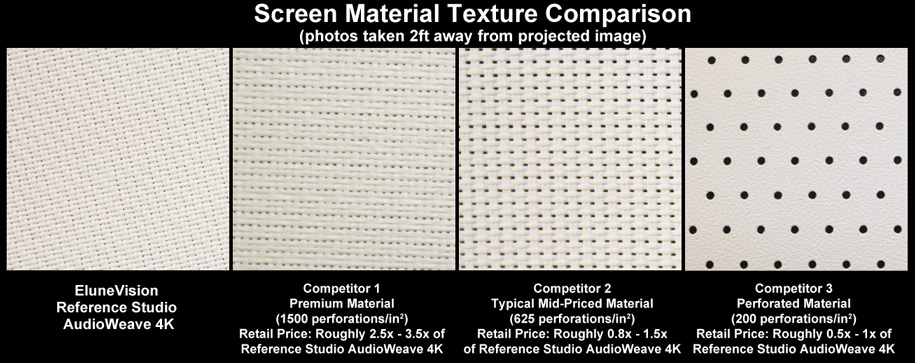
From the above demonstration, it is clear that the EluneVision Reference Studio AudioWeave 4K material beats materials multiple times higher in price, and is far superior than materials even 50% higher in price.
Near Perfect Pixel Geometry
The extremely fine woven weave leaves pixel geometry perfectly intact. Why is this important? With 1080p projectors now standard and 4K projectors on the horizon, EluneVision’s material ensures that the effective resolution remains at 1080p, while other (more expensive) competitors degrade the pixel geometry to the point that the effective resolution is no longer even close to 1080p. Due to the fact that there is near-zero texturing and perfect preservation of detail clarity, the EluneVision Reference AudioWeave 4K material will perfectly resolve 4K resolution in both today’s high end and future 4K projectors, saving you a screen upgrade.
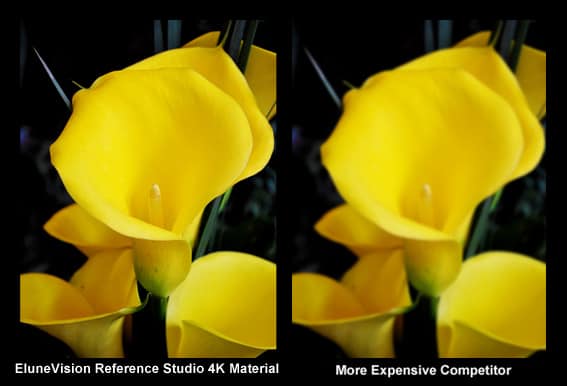
No Sparkles or Graininess – Complete Invisibility of Screen Material
Due to the use of a smooth and near perfect lambertian diffuser material, the screen has absolutely no sparkles. The screen was purposely engineered to disperse the light evenly in a hemispherical distribution, creating a perfect reproduction, as the director intended. The Reference Studio AudioWeave 4K material will easily pass any of the common sparkle tests, which include bright scenes in movies as well as sports such as hockey, football, etc. This means that viewer will always see the image displayed on the screen as the projector manufacturer intended, and will never see the annoying imperfections present on competitors’ screen materials.
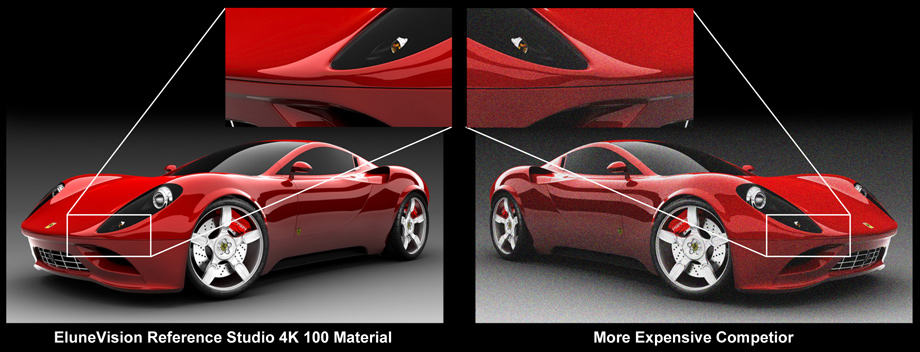
Absolutely No Hot Spotting – 100% Screen Transparency
A big problem that you see with all but the best screens is an issue known as hot spotting. Hot spotting results in an area at the center of the screen with high glare and light, surrounded by a comparably darker image at the top, bottom and sides of the screen. As seen below, this results in a very unnatural image. This is not a phenomenon that only cheaper screens suffer from – there are countless examples of significantly more expensive Reference screens from competitors that suffer greatly from hot spotting, serving as a testament to EluneVision’s engineering efforts in perfecting the Reference Studio AudioWeave 4K NanoEdge screen.

Perfect White Field Uniformity
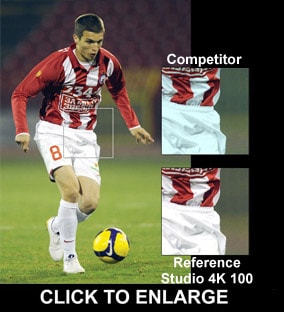 Reference Studio AudioWeave 4K material provides perfect white field uniformity due to the material’s Lambertian diffuser nature. The brightness will be even across the entire screen and there will not be areas of the screen which are brighter or dark to the viewer at any viewing angle. When projecting a pure white scene, the white level will be even from edge to edge, with absolutely no hot-spotting or texturing , demonstrating a reference level of performance and image quality.
Reference Studio AudioWeave 4K material provides perfect white field uniformity due to the material’s Lambertian diffuser nature. The brightness will be even across the entire screen and there will not be areas of the screen which are brighter or dark to the viewer at any viewing angle. When projecting a pure white scene, the white level will be even from edge to edge, with absolutely no hot-spotting or texturing , demonstrating a reference level of performance and image quality.
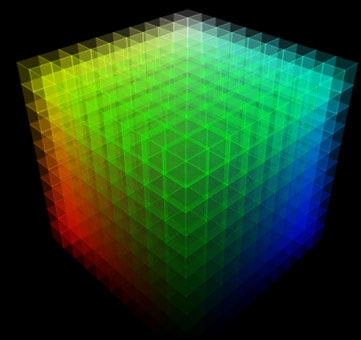
Colour Neutrality and Accuracy
EluneVision’s new Reference Studio AudioWeave 4K material is designed specifically to achieve the highest level of color reproduction. To achieve this, the material is designed for a completely neutral color reproduction. The Lambertian diffuser property, in addition to a specially designed white base color, maintains color accuracy across the entire color gamut. Many other projection materials in the market today will exhibit a shift in hue, either to the blue, green or red. This creates an unnatural balance to the colors and will decrease the color uniformity and vibrancy.
Above, we see a demonstration of this phenomenon. The top zoom-in shows the competitor’s screen versus our EluneVision Reference Studio AudioWeave 4K screen material. Note the color shifts that the competitor exhibits, as well as the minimization color shifts of the EluneVision Reference Studio AudioWeave 4K material. This results in the color accuracy of the whites and the reds you see in the EluneVision Reference Studio AudioWeave 4K screen material image.
Ultra Wide Viewing Angle
Due to the near perfect lambertian diffuser properties of the Reference Studio AudioWeave 4K material, the viewing angle is a full 180 degrees, allowing seats to be placed off axis without any changes in brightness or white field uniformity. The image on the Reference Studio AudioWeave 4K material is consistent from edge-to-edge at all viewing angles.
To demonstrate this, photos were taken and posted below (the images were not re-touched). The first one shows a projected movie in a front view, while the second shows the movie at fairly extreme side view. Though the user would not normally sit this far off center, the photos below demonstrate the fact that in any way that you decide to arrange seating, the screen will perform with perfection from any view-point. This performance extends to the height and location that you decide to mount the projector. Whether ceiling mounted and centered to the screen, or table mounted to far to the left/right of the screen, the image the screen projects back to the viewer will not degrade.
Pure-Flat Tab-Tension System
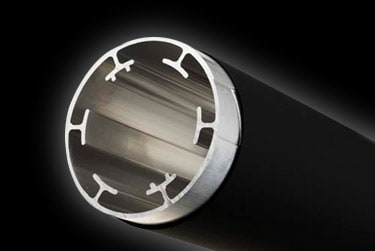 EluneVision Reference Studio 4K Tab-Tensioned motorized screens use our specially designed tensioning system known as Pure-Flat Tensioning system. The first stage of our Pure-Flat Tensioning system involves using an extremely heavy weight bar at the bottom. The bar is made of solid steel and its weight ensures that the screen is under great tension in the vertical direction, thus eliminating swaying from vibrations or moving air.
EluneVision Reference Studio 4K Tab-Tensioned motorized screens use our specially designed tensioning system known as Pure-Flat Tensioning system. The first stage of our Pure-Flat Tensioning system involves using an extremely heavy weight bar at the bottom. The bar is made of solid steel and its weight ensures that the screen is under great tension in the vertical direction, thus eliminating swaying from vibrations or moving air.
The second stage of the tensioning system involves the use of tensioned tabs at each side. This system allows tension to be applied horizontally, ensuring a flat surface. Our specially designed system ensures a smooth flat surface and prevents curling. Year after year, the screen will be flat and wave free.
Wrinkle Free Screen Spindle
As the fabric is rolled into the roller tube, where the fabric first meets the tube will cause a slight indentation that will repeat at regular intervals across the material. This problem is solved by using a symmetrical roller tube with a grove for where the material is first placed into. This ensures there are no repeating horizontal indentations in the material.
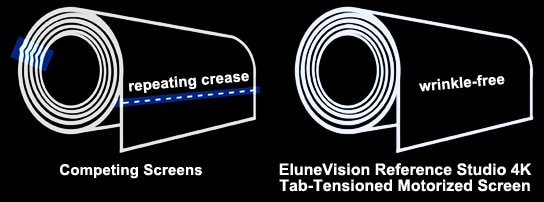
In order to bring you a flat picture, major design innovations had to be employed in the design and engineering of the screens:
-
The Reference Studio 4K 100EL fabric is slightly elastic and therefore works perfectly, as it can be tensioned to create a perfectly flat canvas for your movies.
-
An extremely heavy weight bar is used as the bottom bar. The bar is made of solid steel, to ensure that the screen is under great vertical tension and eliminates swaying from vibrations or air movement in the room.
-
The tensioning system involves the use of tensioned tabs at each side. This system allows tension to be applied horizontally ensuring a flat surface.
-
The tension of the screen can be adjusted using adjustment knobs located at the end of the bottom bar.
Tubular Heavy Duty Motor
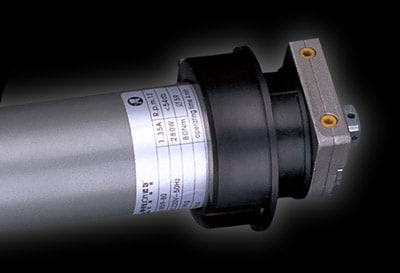 EluneVision motorized screens use a combination of quiet and reliable tubular motor with self-adjusting bearings, The screen rolls down smoothly, as the motor features patented technology which removes vibration and increases smoothness.
EluneVision motorized screens use a combination of quiet and reliable tubular motor with self-adjusting bearings, The screen rolls down smoothly, as the motor features patented technology which removes vibration and increases smoothness.
For the video connoisseur who needs a motorized screen, the only choice would be a tensioned screen, as flatness is key to preserving the media as it was meant to be seen. A surface that is wrinkle-free and without any distortions is the ideal to which a movie will be projected. This is where the Pure-Flat Tab-Tension system really shines.
The screen material is rolled onto a large diameter roller tube, making the screen surface flatter, as there is less curvature in the material when it is rolled up, versus the smaller roller tubes commonly employed by most screen manufacturers.
Solid and Luxurious Construction
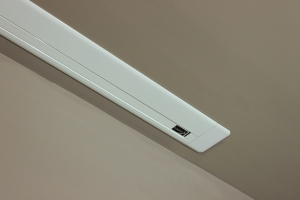 Professional All-Aluminum Housing
Professional All-Aluminum Housing
The Reference Studio 4K series screens have a sleek aluminum housing that is both durable and attractive.
Our heavy-duty housing allow easy access to screen components and installation with a pop-off screen casing cover.
The frame is made from aluminum and fire-resistant materials.
Multiple Screen Control Options
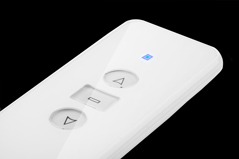
The Reference Studio 4K In-Ceiling Tab-Tensioned screen is designed with many control methods, including a 12V Wired Trigger, RF Remote, IR Control, RS-232 Connection.
Easy to Adjust Down Limit Controls
Clearly marked and easily accessible limit switch adjustment holes allow limit switch adjustments to be done in a snap. A special limit control tool is included with your screens to make this process as simple as possible.
100% Satisfaction Guarantee
 EluneVision stands behind each and every one of our screens. Unlike many other companies which require you to send the product back for repair, we simply just send you a replacement screen. This is our promise and commitment to our clients and customers. Before the new screen is sent out, another round of meticulous inspection is carried out to ensure that a flawless product is received. We work with all our resellers to ensure top-level service for our customers.
EluneVision stands behind each and every one of our screens. Unlike many other companies which require you to send the product back for repair, we simply just send you a replacement screen. This is our promise and commitment to our clients and customers. Before the new screen is sent out, another round of meticulous inspection is carried out to ensure that a flawless product is received. We work with all our resellers to ensure top-level service for our customers.
Long-Term Durability
A screen is something you want to use for many, many years. It is key to purchase a quality screen so that it will outlast many generations of projector upgrades. The projector’s screen is like a painters canvas – a quality screen is needed to show the full performance of today’s and tomorrow’s projectors. The material itself is extremely strong and cannot be easily torn by hand. The screen material can be cleaned easily with mild soapy water and a sponge.
Performance Equal to the Best
The performance of the Reference Studio 4K series is equal to some of the best purposefully designed HD materials. These include Stewart’s Studiotek 100, 130 and Da-Lite’s JKP Affinity. The Reference Studio 4K material is equal to these materials in terms of sharpness, resolution, detail clarity, white field uniformity and viewing angle. The screen also does not suffer from any of the drawbacks such as graininess, texturing and hot spotting that lesser-name screens exhibit.
Superior Value
The value of the Reference series is far superior to that of competitors. We offer the same video performance with much greater quality frames for less than a third our competitor’s prices. In terms of value and performance, the Reference Studio 4K line stands alone.
One Year Warranty
The EluneVision Reference Studio 4K In-Ceiling Tab-Tension Screen is backed with a 1-year warranty against manufacturer defects.






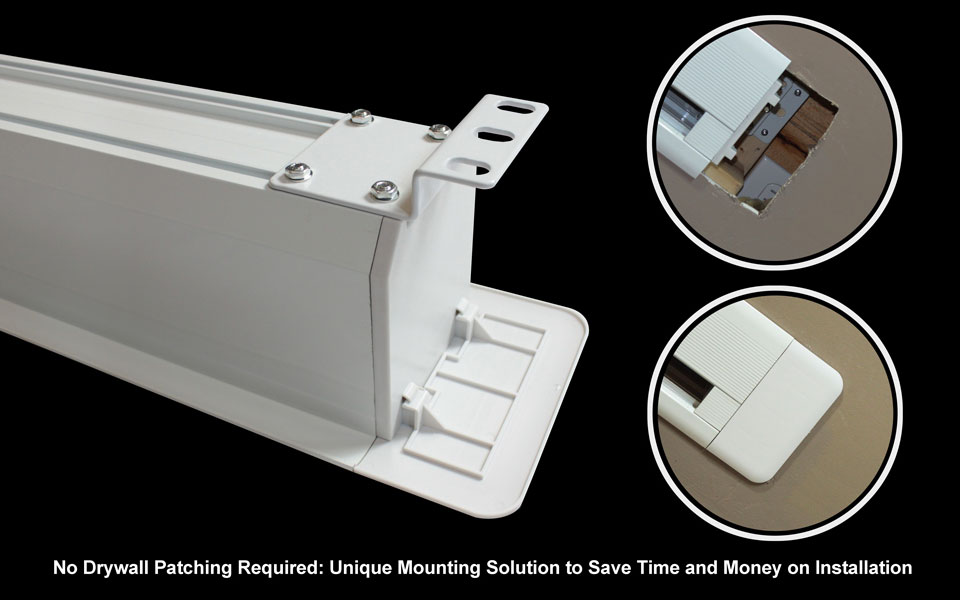









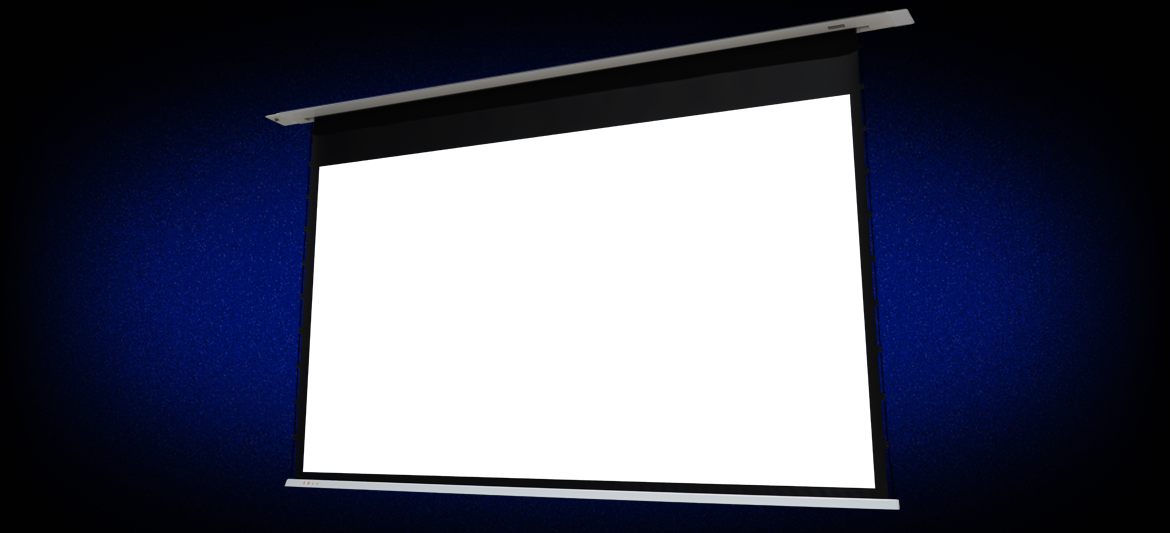
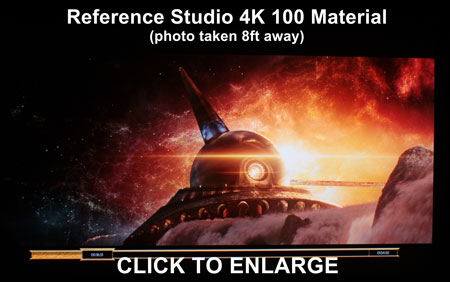
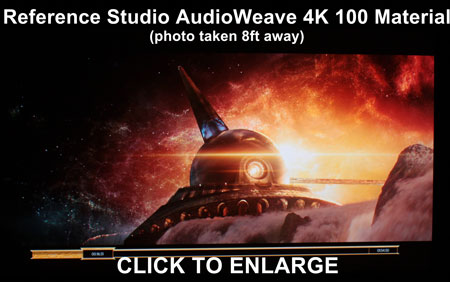
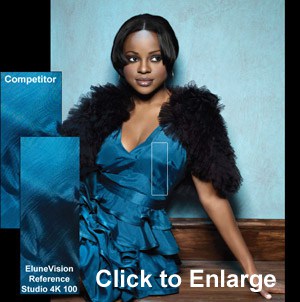
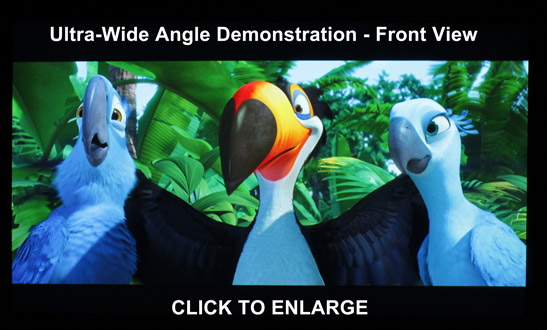
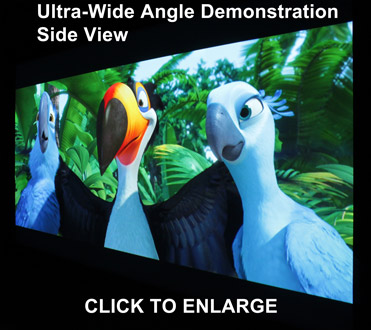
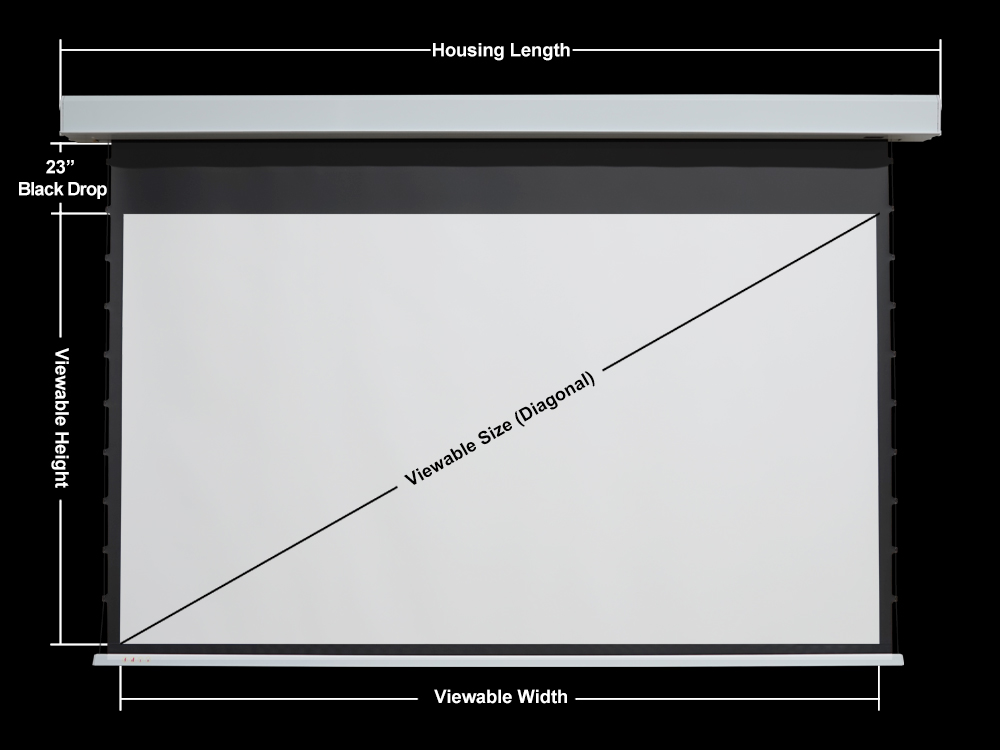
No Comments